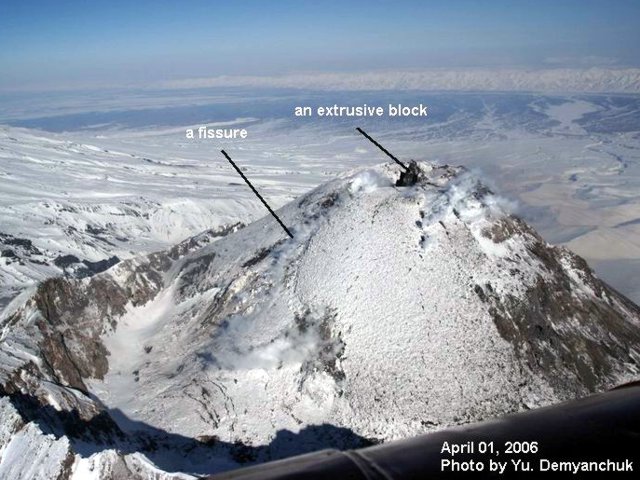Report on Bezymianny (Russia) — April 2006
Bulletin of the Global Volcanism Network, vol. 31, no. 4 (April 2006)
Managing Editor: Richard Wunderman.
Bezymianny (Russia) Pyroclastic flows on 9 May extend 7-8 km; plumes over 500 km long
Please cite this report as:
Global Volcanism Program, 2006. Report on Bezymianny (Russia) (Wunderman, R., ed.). Bulletin of the Global Volcanism Network, 31:4. Smithsonian Institution. https://doi.org/10.5479/si.GVP.BGVN200604-300250
Bezymianny
Russia
55.972°N, 160.595°E; summit elev. 2882 m
All times are local (unless otherwise noted)
This report describes a substantial eruption on 9 May 2006, and events before and shortly afterwards. Bezymianny was last reported on in BGVN 30:11, covering a series of events during mid-January through late December 2005.
An explosive eruption occurred on 30 November 2005. Seismicity decreased subsequently and from January to the end of April 2006, Bezymianny remained comparatively calm; fumarolic activity and a small thermal anomaly were observed during periods of good visibility. A 1 April aerial photo of the summit area appears as figure 6.
During 28 April to 5 May, Bezymianny's lava dome continued to grow. Seismicity was above background levels during 30 April to 3 May. Incandescent avalanches were visible on 4 May. At the lava dome, fumarolic activity occurred and thermal anomalies were visible on satellite imagery. Bezymianny was at Yellow on the four stage Concern Color Code (low to high–Green, Yellow, Orange, Red).
On 7 May the Concern Color Code was raised to Orange due to an increase in seismicity and the number of incandescent avalanches (14 occurred on 6 May in comparison to 4-6 during the previous 2 days). Intense fumarolic activity occurred, with occasional small amounts of ash. KVERT reported that an explosive eruption was possible in the next 1 or 2 weeks.
9 May eruption. On 9 May around 1935, the Concern Color Code was raised to Red, the highest level, due to increased seismicity and incandescent avalanches. A gas plume rose higher than 7 km altitude and a strong thermal anomaly was visible on satellite imagery.
An explosive eruption occurred on 9 May during 2121 to 2145. The explosion produced an ash column that rose to a height of ~ 15 km altitude. A co-ignimbrite ash plume was about 40 km in diameter and mainly extended NE of the volcano. Ash plumes extended more than 500 km ENE from the volcano. Pyroclastic flows deposits extended 7-8 km from the volcano.
On 10 May around 0100, seismicity returned to background levels and the Concern Color Code was reduced to Orange. Small fumarolic plumes were observed during the early morning of the 10th and lava probably began to flow at the lava dome.
By 11 May seismic activity was still at background levels. Gas and steam plumes were visible above the volcano. A thermal anomaly was noted at the volcano on 10-11 May. Lava effusion was probably occurring at the lava dome. This was interpreted to mean that the likelihood of a large, ash-producing eruption had diminished.
Geological Summary. The modern Bezymianny, much smaller than its massive neighbors Kamen and Kliuchevskoi on the Kamchatka Peninsula, was formed about 4,700 years ago over a late-Pleistocene lava-dome complex and an edifice built about 11,000-7,000 years ago. Three periods of intensified activity have occurred during the past 3,000 years. The latest period, which was preceded by a 1,000-year quiescence, began with the dramatic 1955-56 eruption. This eruption, similar to that of St. Helens in 1980, produced a large open crater that was formed by collapse of the summit and an associated lateral blast. Subsequent episodic but ongoing lava-dome growth, accompanied by intermittent explosive activity and pyroclastic flows, has largely filled the 1956 crater.
Information Contacts: Olga Girina, Kamchatka Volcanic Eruptions Response Team (KVERT), a cooperative program of the Institute of Volcanic Geology and Geochemistry, Far East Division, Russian Academy of Sciences, Piip Ave. 9, Petropavlovsk-Kamchatsky, 683006, Russia, the Kamchatka Experimental and Methodical Seismological Department (KEMSD), GS RAS (Russia), and the Alaska Volcano Observatory (USA); Alaska Volcano Observatory (AVO), a cooperative program of the U.S. Geological Survey, 4200 University Drive, Anchorage, AK 99508-4667, USA (URL: http://www.avo.alaska.edu/), the Geophysical Institute, University of Alaska, PO Box 757320, Fairbanks, AK 99775-7320, USA, and the Alaska Division of Geological and Geophysical Surveys, 794 University Ave., Suite 200, Fairbanks, AK 99709, USA.


